INVESTIGATIVE REPORTING PROJECT: Why Filipinos shy away from Chapel of San Lorenzo Ruiz dedicated to them (Part 1)
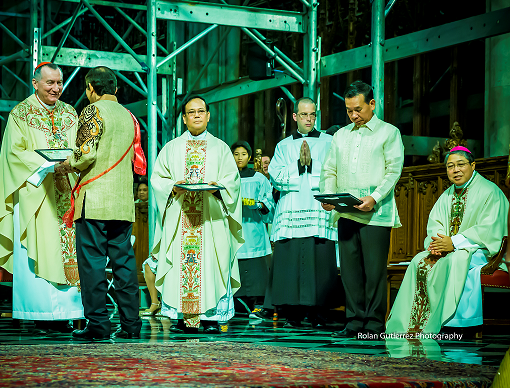
Fr. Joseph Marabe approaches altar to celebrate Mass on the Feast Day for San Lorenzo Ruiz. Photos by Rolan Gutierrez and Sharon Adarlo
UPDATE: DNA Info is reporting that the Chapel of San Lorenzo Ruiz is being sold for $7.35 million to a real estate developer. The sale is expected to close by July 25, 2017. Below is the story of the church dedicated to Filipinos and yet forsaken by the community.
By Sharon Adarlo
Amidst the trendy eateries and high-end boutiques of Manhattan’s Nolita neighborhood, the small chapel on Broome Street is a serene edifice of multicolored, rustic brick and carved Gothic-style lintels and columns.
Its specialness is revealed when you come closer. The Philippines flag flies over the entrance. And Christmas lights and lantern ‘parol’ made of capiz or the shells of the windowpane oyster are strung from the windows and above the iron gate.
The church is not just any church: the Chapel of San Lorenzo Ruiz is the “first and only Catholic church dedicated to Filipinos in the United States,” according to the chapel’s website.
Several years after its dedication to the Filipino community in June 2005, the chapel has experienced highs and lows. Then Philippine President Gloria Macapagal-Arroyo attended the first Mass that year. Throngs of Filipino Americans at first crowded the church for Mass, but attendance dwindled so much so that The New York Times published a story on the sparse crowds in 2006. But a recent visit to the chapel revealed that it has developed a steady following from some Filipinos, a few who travel as far as Pennsylvania and Connecticut.
Regular attendance at the chapel averages around 20 to 30 for weekday Masses, while Sunday Masses attract 50, according to some members. Special occasions such as family prayer events attract 100 or more. This is a far cry from the Times article which reported on a Mass that had only two people — the priest and an elderly woman who lived in the neighborhood.
“It’s become a family home — a home away from home. It’s become a home for Filipinos,” said Rev. Dr. Joseph G. Marabe in an interview with The FilAm for this report. Marabe, the chapel’s priest, talked about how the church has become a gathering spot over the last several years for Filipino Americans.
Though attendance is healthier than before, The FilAm asked Marabe why the chapel attracts a relatively small portion of the burgeoning Filipino population in the New York metro area. According to U.S. Census figures from 2010, Filipinos are the fourth largest Asian group in the area and number more than 13,000 in the Manhattan borough alone.
Marabe said it’s because the church is located in an area with no Filipinos, many of whom live in Midtown Manhattan and the outer boroughs. But because the chapel is a chapel and not a parish church, the chapel doesn’t need to attract the same amount of crowds, he explained.
“Anyone can come. Even if they don’t reside here, they can come,” he said.
A former church member, who is not named, said the lack of Filipinos in the area was not the only factor on why attendance dwindled in the past. Parking is expensive in the area, making it hard to access. Decreased attendance was also due to infighting among different church members and priests from the Archdiocese of New York, who all had competing visions on what the chapel could offer — such as disputes over devotions to different saints and the display of certain statues.
The unnamed church member also alleged that the chapel was not transparent with its financial accounts.
But when the public walks upstairs to the social hall above the sanctuary, the chapel’s financial records are displayed openly on a bulletin board in a common hallway. Marabe said members give enough money to support the church. The church also receives bequests in the wills of deceased Filipinos.
“So far, so good. We are surviving,” said Elmer Villaluz, the chapel’s volunteer treasurer.
The church’s operating budget averages $6,000 a month, he said. The bills are for electricity, maintenance, and other expenses. Collections for the church for the most part break even with the monthly expenses.
But the chapel still needs help, said Villaluz. Every Wednesday, the chapel provides food to parishioners in need. It would be nice to have more money to fund these outreach services, he said.
On a recent rainy, cold night in October, about 30 people had braved the wicked weather to attend Wednesday evening Mass.
“It’s like very solemn, peaceful and prayerful, and it’s a beautiful shrine,” said Corazon Rivera, a Manhattan resident.
“It’s because it’s our only Filipino church in the Tri-state area. So we have to support it,” said Linda Bolano, a member who comes all the way from Poconos, Pennsylvania and is on the chapel’s oversight committee, on why she attends Mass.
Besides Masses, Filipinos from all over the New York City area come to the small church to celebrate weddings, baptisms, funerals, birthday parties, special dinners, and other community events.
It wasn’t always like this. The church was first built in 1925 and was known back then as the Holy Crucifix Church, according to Marabe and the church’s website. The burgeoning Italian community was the church’s main patrons, who held sway in Little Italy, a holdover of the infamous Five Points slums as immortalized in Martin Scorsese’s “Gangs of New York.”
But as many Italians moved out of the city over the last century and Asians started to immigrate to the United States, some Filipinos lobbied for their own church. Finally in June 2005, the church was rededicated to the Filipino community and renamed after San Lorenzo Ruiz, the first Filipino saint who died in 1637 after being jailed and tortured on a missionary trip to Japan.
Masses, which are held three times a week, service a mostly Filipino congregation but also other ethnicities, said Marabe, who has been at the chapel for the last five years. He is also a priest-in- residence at Saint Patrick’s Cathedral in Midtown. The church holds about 250 people while the social hall, where many parties have been held, holds 60.
Marabe holds his sermons in not just English and Tagalog, but also Spanish and Italian, being fluent in all four languages.
“So people could follow,” he said about switching between his mother tongue to the others. To help people further, there is a projector in front that translates phrases.
The chapel also serves as a temporary shelter for pilgrims coming to visit the church and they typically stay one to two days, said Marabe. The church, which has a few rooms for sleep, is also an emergency shelter for Filipinos who are in transit or stranded in the city and are on their way back to the Philippines.
“We are allowed to have temporary shelter. It’s not a regular thing,” he said. “We can accommodate one or two people for one or two days only. The consulate refers them to us so we can help them.”
When special days come along, such as the Feast of San Lorenzo Ruiz, which falls on Sept. 28, service is moved to Saint Patrick’s because there is more room there, said Marabe.
About 2,000 people came to the feast day festivities this year and the reception was held at the New York Palace Hotel across the street, he said. Besides United Nations and Catholic officials and other dignitaries, the main celebrant was the Vatican’s Secretary of State, Cardinal Pietro Parolin. Filipino Archbishop Bernardito Cleopas Auza, the Vatican’s envoy to the United Nations, was also present.
NEXT: Fr. Joseph Marabe breaks silence over Simbang Gabi ban
The FilAm’s Investigative Reporting Project is made possible through the generous support of our readers and contributors including the following:
Consuelo Almonte
Melissa Alviar
Amauteurish.com
Bessie Badilla
Sheila Coronel
Joyce and Arman David
Menchu de Luna Sanchez
Kathleen Dijamco
Jen Furer
Marietta Geraldino
Dennis Josue
Lito Katigbak
Rich Kiamco
Monica Lunot-Kuker
Michael Nierva
Lisa Nohs
Cecilia Ochoa
Rene & Veana Pastor
John Rudolph
Roberto Villanueva
2 anonymous donors
Sharon Adarlo is a freelance writer and artist based in Newark, New Jersey. Her writings have appeared in the Wall Street Journal, The Star-Ledger, Al Jazeera America, the Daily Beast, the Awl, and other publications. Follow her at sharonadarlo.com.



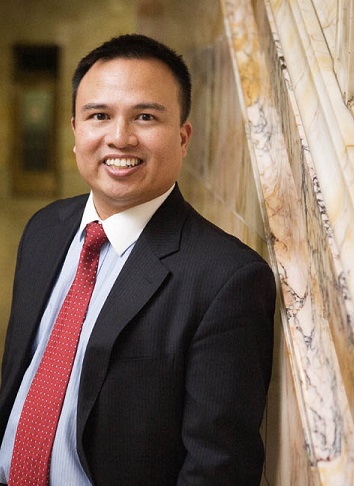


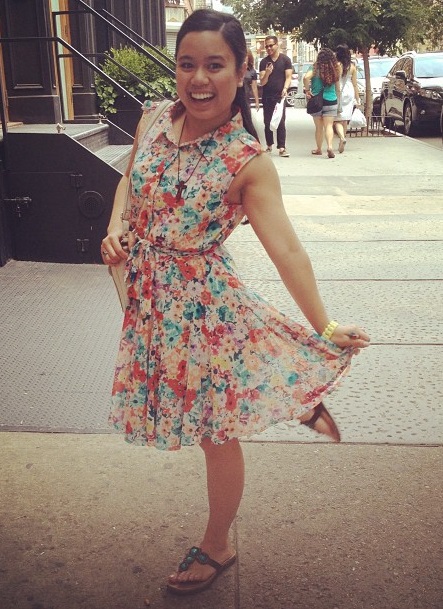

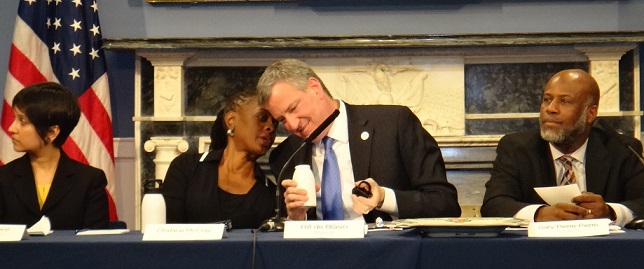

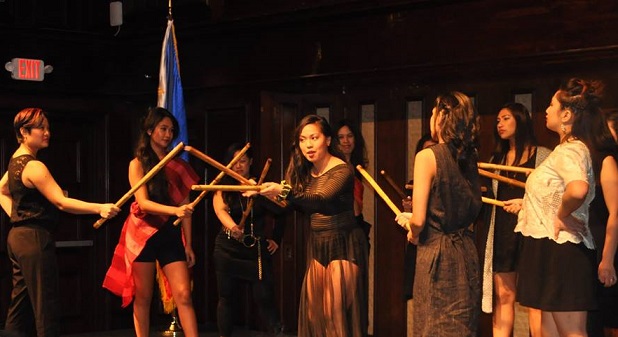
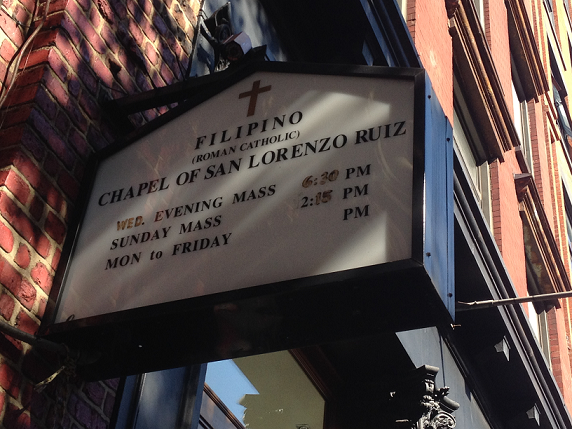
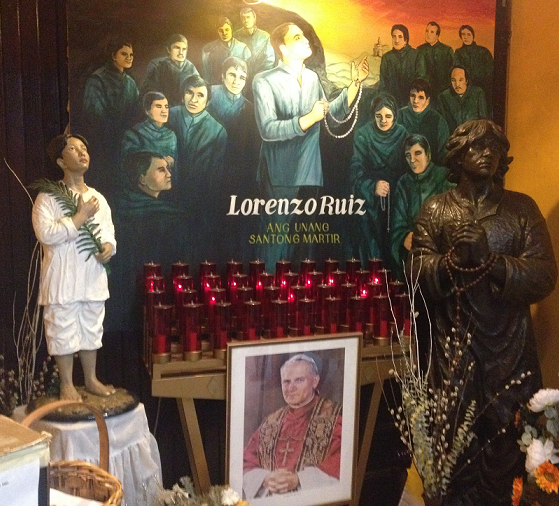

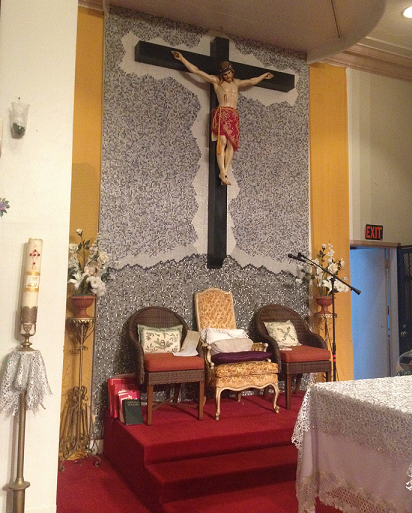

[…] INVESTIGATIVE REPORTING PROJECT: Why Filipinos shy away from Chapel of San Lorenzo Ruiz dedicated to… […]
I think the answer is similar to why many Filipino restaurants also struggle to survive: Filipinos in the ‘States do not tend to live in Filipino enclaves unlike other ethnicities; one reason being most Filipinos who live in the US are already fluent in English, and don’t need to stay close to other Filipinos who had arrived earlier to survive. Other ethnicities, because of the language and other cultural barriers, need to live close to people who speak the same language and who could orient them on how to survive and prosper in the ‘States. And with a large neighborhood of people who share the same culture, a restaurant that serves their native cuisine has a ready market; it’s like a home-cooked meal is just around the corner. However a Filipino restaurant in, say, New York depends on the unrealistic hope that its primary customers would travel from literally far and wide just to have a meal that they themselves could cook at home (with varying degrees of competence, of course). In the same way, why would Fil-Am Catholics go all the way to the chapel of San Lorenzo Ruiz when they can go to Mass at the nearest parish church and readily understand and participate in the rites?
[…] attend only number around 20 to 30 for weekday Masses and 50 on Sundays, members tell The FilAm. In an interview with Rev. Dr. Joseph G. Marabe, reporter Sharon Adarlo asks why, in a borough […]
Thanks and I read the whole article. Yes parking can be a problem and people tend to go away for that reason alone. But living in the U.S. for some 20 years now made me realize that Pinoys dont tend to live close to one another. Most of the people that are living not far from one another are long time friends who invited them to live closer when they decided to buy their homes. It is not the norm for Pinoys to live close to one another overseas. We tend to live far from each other and we only meet on Sundays and especially when there are events in our local associations. In Philadelphia there is a thriving Catholic congregation at Old St. Augustine’s Church which is also the National Shrine of the Santo Nino de Cebu. I have attached a link herein:
https://pinoyphilly.com/affiliates/santo-nino-shrine/
Thanks for this beautiful writing.
for sure there’s someone out there can halt and stop this
why seems there’s a rush? just asking.
I like this internet site because so many interesting stuff on here.
This is precisely why the need for strong investigative reporting becomes even greater. While traditional media outlets may shy away from certain stories in fear of government intrusion or advertising boycotts, this magazine has no such limitations.